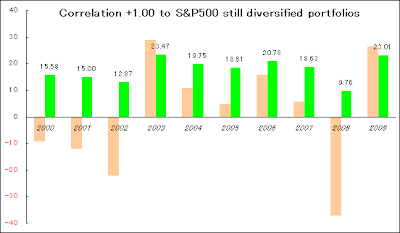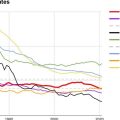NO you are NOT diversified because the way relationships and dependencies are calculated between allegedly “different” asset classes and securities is WRONG. Correlation metrics have nothing to do with achieving diversification. Most “experts” don’t know how easy it is to prove that for any time series of any length, there exist infinite other PERFECTLY CORRELATED (+1.0) data sets but still INCREASE diversification. That simple fact invalidates Markowitz-Sharpe portfolio “optimization”. Trillions are wrongly invested due to dumb guesses, pathetic analytics, absurd assumptions, dubious advice and junk statistics.
Corollary also applies: infinite other data sets exist that are zero or perfectly negatively correlated (-1.0) but REDUCE diversification. Simple proof but ignored by the asset allocation crowd selling their risky ideas. No wonder most pension plans are in a disastrous liability funding state despite having paid massive fees for so-called advice and bad math. The efficient frontier is dangerously INEFFICIENT.
“Standard” deviations and the “correlation” contradiction render mean variance portfolio optimization nonsense. It destroys the premise upon which so many portfolios are supposedly risk/return “optimized”. Pension consultants and investment “experts” are paid vast fees to conjure up elaborate correlation matrices which are USELESS even in the highly unlikely chance such “capital market assumptions” turn out to be correct!
Correlation estimates are worthless. What is the point of an elaborate correlation matrix – guesses on future correlations between asset classes – when the metric itself is FAILS to capture pairwise relationships and dependencies between those assets? If the guesses are wrong or right is irrelevant. I’m seen far too many “uncorrelated” strategies totally dependent on an “up” market. And good managers excluded because they had a “high” correlation.
Securities rising and falling together? Diversification has nothing to do with correlation. Correlation is a misleading metric of no help in portfolio construction. “Modern” portfolio theory is based on dangerously flawed statistics. Conventional wisdom is wrong: highly correlated funds CAN diversify portfolios but some “uncorrelated” strategies are dependent on market factors.
Correlation doesn’t measure dependence. Below is a hypothetical fund with consistent reliable absolute returns every year and CAGR +17.65% but PERFECTLY correlated to the viciously volatile and unreliable S&P 500. Risk and return are unconnected AND uncorrelated. The fund provided great diversification despite calamitous correlation. More “sophisticated” tools like cointegration and copulas are also useless.
So much for Markowitz and Sharpe. The converse is also true. A zero correlated asset can be completely dependent on the underlying. Check out something as simple as Y=X*X. Y has no correlation to X but depends fully on X. Plenty of “uncorrelated” products pretending to be “hedge funds” need up markets to make money. Why bother with closet index funds marketing themselves as “absolute return” products?
The diversification “free lunch” has been arbitraged away, at least in mainstream risky asset classes. The best way to diversify a long is with a short NOT another long. Diversify the right way not diworsify the old way but correlation is STILL used as a critical input for portfolio construction and risk management. Why?
During meltdowns correlations rise but now it occurs in “normal” market conditions as well, adding to risk rather than reducing it. Securities may move together more due to herding, ETFs and algorithmic trading. The passive mania forces benchmark components up or down regardless of value whether stocks, bonds or commodities. Hasn’t everyone learnt the danger of “cheap” index tracking and its expensive cost?
Beta is often cited as a measure of volatility. But it’s really correlation adjusted for the relative volatilities of the fund and benchmark. You can have a low beta security that is high risk and a high beta fund LESS risky than the market. Idiosyncratic risk isn’t a risk; it’s the idiosyncratic alpha you want. Alpha and absolute returns aren’t the same. The textbook calculations of beta and alpha are based on correlation which, as the example above shows, isn’t useful. The identification of true beta – dependence on underlying risk factors – and true alpha – value added through skill rather than luck – is much more complicated.
The omnipotent correlation matrix drives much portfolio “optimization”. A bunch of inputs from data dredging history whose forward-looking output is even more error prone. Garbage in, garbage squared out. Correlation is a bad measure of magnitude. On “up days” most stocks go up but they don’t all rise by the same percentage. Relative value strategies take advantage of varying price moves even if in the same direction. I don’t mind if an investment has correlation of +1.00, 0.00, -1.00 or anything in between. It’s irrelevant. I do care it has minimal sensitivity to anything else in the portfolio. Sadly for investors MVO and CAPM have been shown to be simple, elegant and completely useless. MPT is pronounced EMPTY and is better called Mediocre Portfolio Theory.
“Modern” portfolio theory requires lots of wild guesses known as capital market assumptions, including expected returns, expected volatilities and expected correlations. Scary how trillions are invested in this weird way and the poor “results” speak for themselves. Those variables aren’t robust, stable or likely to be accurate in constructing a long term portfolio.
I’ve kept track of such facile forecasts and the tea leaf reading so-called “experts” who made them. Pretty bad outcomes but those fortune teller predictions keep being used. We are ALL affected by assets being (mis) allocated in this failed framework. Unlike the crystal ball gazers, I find mispriced securities and safer strategies whose returns outweigh the risks. Is that so radical? At least it works.
Severe drawdowns are unacceptable. It is not surprising conventional wisdom has performed so badly with fake “Nobel” prizes awarded for such “efficient”, mean variance “optimized” nonsense. Past asset class returns are no indication of the future over any time horizon including centuries, standard deviation does not measure risk and correlation gives no insight on risk factor dependence.
So why is this stuff still used? Everybody knows everything so the markets are random, right? CMA causes almost as many problems as absurd actuarial assumptions. If you keep doing what you always do, you receive what you always get: growing liabilities AND declining assets. Safer to go with skill-based strategies that offer absolute alpha not repackaged beta.
Dispersion? Every month reports emerge on how AVERAGE “hedge funds” performed. Those numbers are meaningless with such disparity of skills and zero-sum nature of alpha. Many public domain strategies are too well-known now so it is not surprising AGGREGATE alpha tends to zero. Skill is rare. The average hides a range of numbers from managers performing very well to many that did not. 2008 saw huge dispersion. The typical hedge fund lost -20% but over 2000 MADE money. True diversification costs 2 and 20 and the quantitative and qualitative resources to isolate manager skill from luck. The basic arithmetic of R-squareds, covariances and variances just don’t make the grade.
The best sources of low dependence are diversifying by time horizon and spatially. High frequency trading continues to perform well. Amazing how the majority of portfolios still don’t allocate to this reliable source of alpha. Last decade was great and returns have also been good this so-called “challenging” year. If algos do constitute 65% of all trading in liquid securities, perhaps a model portfolio should have 65% allocated to HFT? Despite many years of superior returns most investors avoid high frequency strategies! Perhaps “buy and hold for milliseconds” is the natural evolution from the archaic “buy and hold for years”. Everything operates on short time horizons nowadays which is a mismatch with so-called “long term” investing. Instead I favor long term performance.
Emerging markets have also had high dispersion with frontier markets tending to outperform. Frontiers are less dependent on the world economy while the term “emerging markets” is often semantic arbitrage for countries that are actually developed. The big BRIC has lost badly to my BRIC but the SLIME has been the star this year. Sri Lanka, Iran, Mongolia and Estonia were missed by almost all international strategists. Could the geographic diversification strategy nowadays be to invest in places that don’t offer ETFs? Don’t asset allocate X% to emerging market beta. Invest 100% in alpha WHEREVER it can be found.
Unlike that unreliable, unskilled, unhedged trio of unknown FUTURE asset class statistical parameters, I know that a properly diversified portfolio of the best managers properly incentivized to work hard and apply rare skills to their money and yours will deliver over time in all possible scenarios. Changing markets and crowded trades are no excuse for not being able to deliver absolute returns. Of course no-one avoids losses sometimes which is why risk management and low similarity between strategies is important.
Two investment products might or might not be correlated but one can be vastly superior and safer than the other. Avoid managers dependent on underlying markets and focus on skill-based strategies. I prefer calculating co-relation and association metrics not coRRelations. High asset co-dependencies show the markets are even more inefficient. REAL strategy diversification is what investors need.


